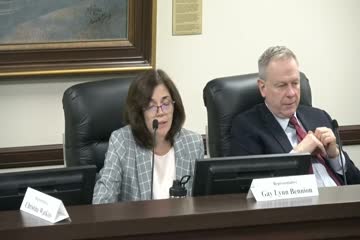Experts Warn of Wildlife Crisis Amid Climate Extremes
October 16, 2024 | Utah Interim, Utah Legislative Branch, Utah
This article was created by AI summarizing key points discussed. AI makes mistakes, so for full details and context, please refer to the video of the full meeting. Please report any errors so we can fix them. Report an error »

During a recent government meeting, discussions centered on the impacts of climate change on wildlife, particularly in light of the ongoing drought conditions in the region. The meeting highlighted insights from the conservative climate summit held at Utah Valley University, where experts, including Dr. Katherine Hayhoe from The Nature Conservancy, addressed the phenomenon of \"climate weirding.\"
A key focus was on the effects of extreme weather patterns on wildlife populations, specifically mule deer and other big game species. Officials noted that years of severe drought have necessitated habitat restoration efforts through initiatives like the Watershed Restoration Initiative. These efforts aim to improve conditions for wildlife, which have been severely affected by fluctuating water availability and unpredictable weather.
The discussion emphasized the critical relationship between water resources and wildlife health. For instance, the availability of monsoon moisture is vital for deer populations in the southern part of the state, while harsh winters can adversely affect them in the north. The meeting underscored that wildlife behavior is highly dependent on local environmental conditions, with deer adapting their movements based on food availability and moisture levels.
Furthermore, the meeting touched on the collaborative efforts between public and private landowners to enhance water and range development, benefiting both livestock and wildlife. As the conversation progressed, questions arose regarding the methodologies used to monitor wildlife populations, particularly cougars, indicating a need for more detailed understanding of wildlife management practices.
Overall, the meeting served as a platform for addressing the pressing challenges posed by climate change on local ecosystems and the ongoing efforts to mitigate these impacts through scientific research and community collaboration.
A key focus was on the effects of extreme weather patterns on wildlife populations, specifically mule deer and other big game species. Officials noted that years of severe drought have necessitated habitat restoration efforts through initiatives like the Watershed Restoration Initiative. These efforts aim to improve conditions for wildlife, which have been severely affected by fluctuating water availability and unpredictable weather.
The discussion emphasized the critical relationship between water resources and wildlife health. For instance, the availability of monsoon moisture is vital for deer populations in the southern part of the state, while harsh winters can adversely affect them in the north. The meeting underscored that wildlife behavior is highly dependent on local environmental conditions, with deer adapting their movements based on food availability and moisture levels.
Furthermore, the meeting touched on the collaborative efforts between public and private landowners to enhance water and range development, benefiting both livestock and wildlife. As the conversation progressed, questions arose regarding the methodologies used to monitor wildlife populations, particularly cougars, indicating a need for more detailed understanding of wildlife management practices.
Overall, the meeting served as a platform for addressing the pressing challenges posed by climate change on local ecosystems and the ongoing efforts to mitigate these impacts through scientific research and community collaboration.
View full meeting
This article is based on a recent meeting—watch the full video and explore the complete transcript for deeper insights into the discussion.
View full meeting

